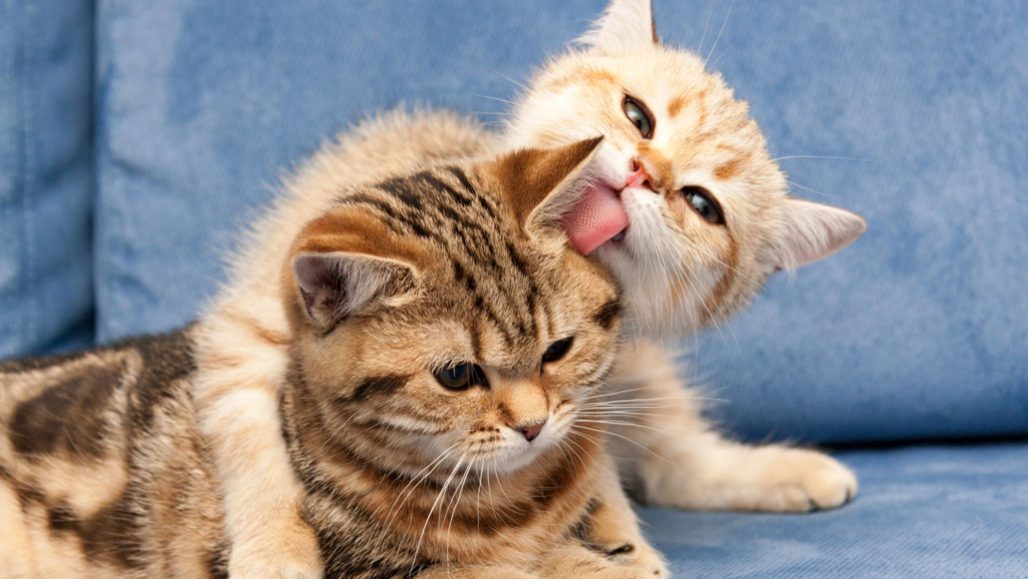Giving cats a special food may one day help people with cat allergies
Pet-food maker Purina is studying how adding an antibody to cat chow curbs allergic reactions

Most cat allergies are triggered by a protein called Fel d1. It’s carried in cats’ saliva. New research aims to disable the protein at its source.
SunRay BRI Cattery RU/iStock/Getty Images Plus
Cat lovers who sneeze and sniffle around their feline friends might one day find at least partial relief in a can of cat food. This won’t be ordinary cat food, though. It will contain an antibody to the major allergy-causing protein in cats. This protein is called Fel d1. New research suggests that feeding its antibody to cats changes the protein so that the human immune system can’t recognize it. That reduces the allergic response.
Researchers fed the antibody to 105 cats for 10 weeks. After that, the amount of active Fel d1 protein on the cats’ hair dropped by 47 percent on average. Researchers from pet food–maker Nestlé Purina conducted the research. They reported their results in the June Immunity, Inflammation and Disease.
Nestlé Purina researchers also conducted a small pilot study with 11 people allergic to cats. These people were exposed in a test chamber to hair from cats fed the antibody diet. They were also exposed to hair from cats fed a normal, control diet. The people had reduced nasal symptoms and less itchy, scratchy eyes with the hair from cats fed the special diet. These preliminary findings were released in June. The researchers presented them in Lisbon, Portugal. They were at a scientific meeting called the European Academy of Allergy and Clinical Immunology Congress.
Lick, lick, lick
The Fel d1 protein is produced in cats’ salivary and sebaceous glands. Cats transfer the protein to their hair when they groom by licking themselves. They also excrete it in their urine. Humans are then exposed to the protein on cat hair and dander — dead skin — or in the litter box. Cat allergies plague up to 20 percent of people. Fel d1 is responsible for an estimated 95 percent of allergic reactions to cats.
About this story
Why are we doing this story?
When I learned that Purina was developing a cat food aiming to reduce human exposure to the major cat allergen, Fel d1, I knew readers would want to know whether it works, and how. I did, too; my husband is allergic to cats, and last year we checked out breeds that, according to recent genetic research, may be more likely than others to have naturally low Fel d1 levels. We found a lovable Siberian who doesn’t make my husband sneeze.
Who did we speak to?
Since this research is sponsored by a company with a financial stake in the outcome, I wanted to talk to an outside expert who had no ties to the research. I felt it was most important to get a clinical perspective — is this approach really likely to help allergy sufferers? — so I contacted an expert in immunology and allergies.
— Erika Engelhaupt
What’s this box? Learn more about it and our Transparency Project here. Can you help us by answering a few brief questions?
Doctors can’t have humans consume these antibodies. That’s because the molecules are broken down in the gut. They would never reach their targets in the body, says Michael Blaiss. He is executive medical director of the American College of Allergy, Asthma and Immunology. He’s also an allergist and immunologist at the Medical College of Georgia in Augusta. Purina’s approach to the cat allergy problem is interesting and unusual, he says.
The antibody to Fel d1 is derived from eggs. It’s then added to cat food. In cats, it works in the mouth. There, it neutralizes the protein in saliva, says Ebenezer Satyaraj. He is director of molecular nutrition at Purina. He’s leading the cat allergen research. With this approach, the antibody disables Fel d1 “after its production by the cat, but before it spreads to the cat’s hair and dander — and before a response occurs in an individual sensitized to cat allergens,” says Satyaraj.
This approach doesn’t interfere with the normal production of Fel d1 by the cat, Satyaraj says. This is good because scientists aren’t sure how cats use Fel d1 in their bodies. Stopping its production could have unknown side effects. But so far, he adds, safety tests have found no harm to cats fed the antibody.
Blaiss expects that the new treatment may help people with mild cat allergies. But those with severe symptoms may be out of luck. They are unlikely to find relief from cutting the amount of active allergen only in half. Some people can’t tolerate any amount of the protein without symptoms, he says. What’s more, different cats can produce very different amounts of Fel d1 naturally. “So it just depends on the [Fel d1] levels of the cat and the symptomology of the patient,” he says.
In addition, Fel d1 is known to be a “sticky” protein, Blaiss says. It tends to stick around and accumulate in the home over time. So even if a person feeds their cat the antibody-laced food, “it could just take more time to build to a level that triggers an allergic reaction.”
Purina is not yet offering products containing the antibody, Satyaraj says. However, the company plans further research to determine how well it might work for reducing cat allergens in the home.







